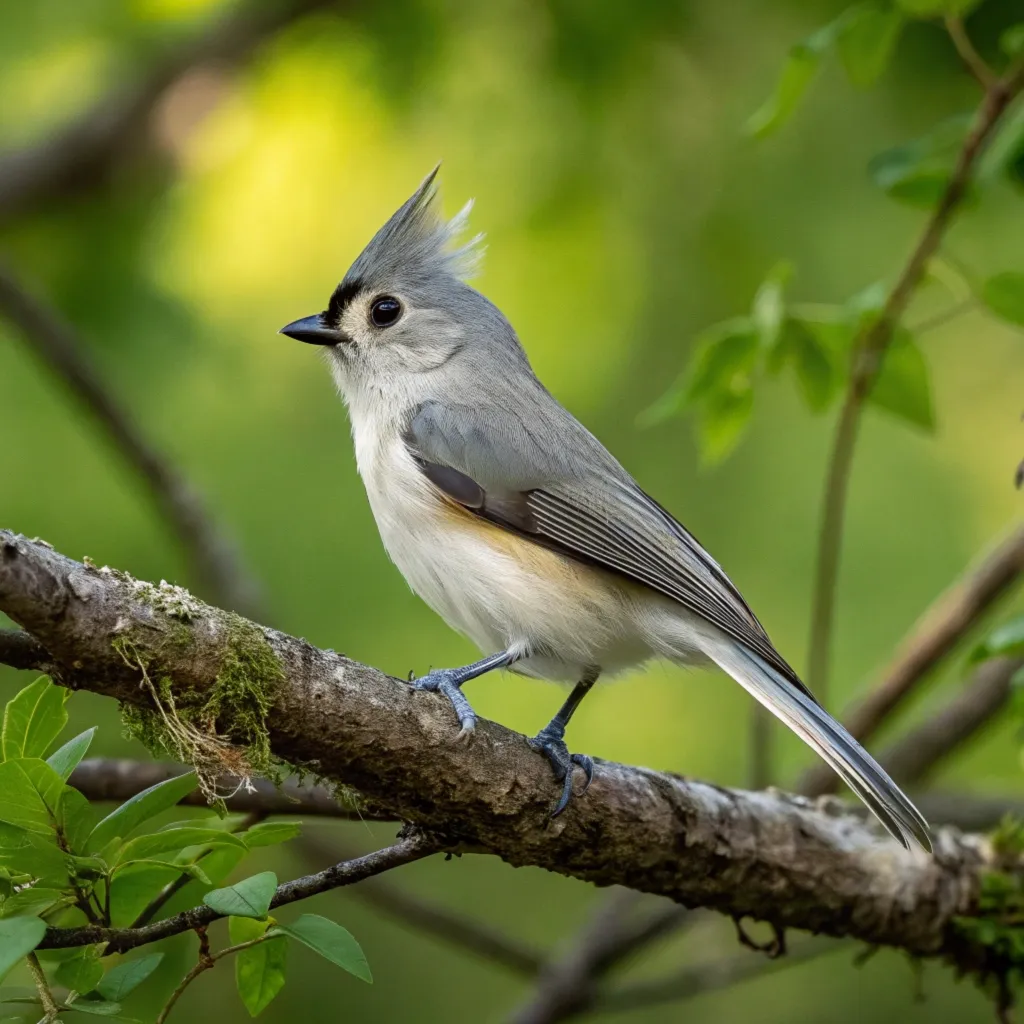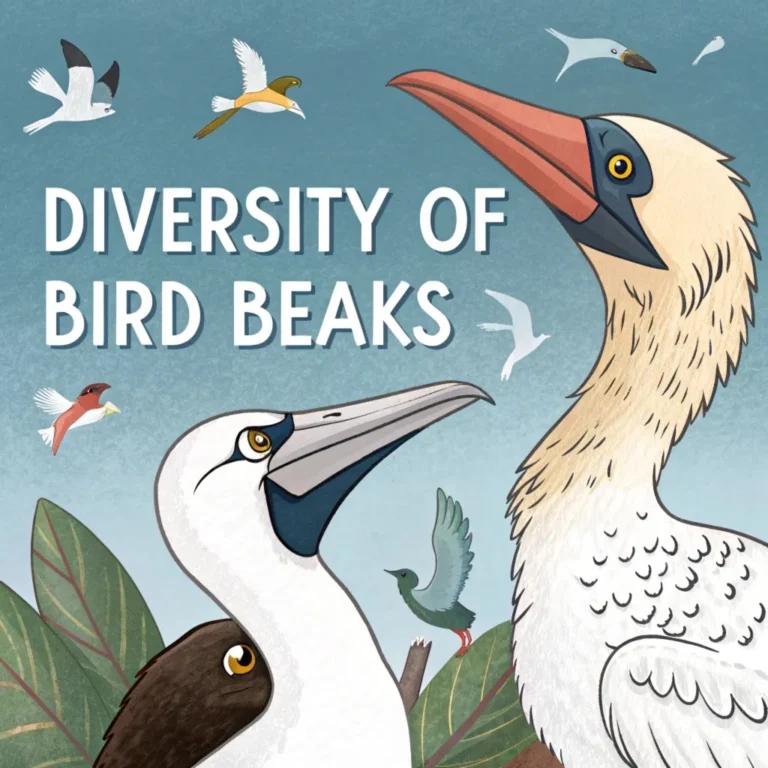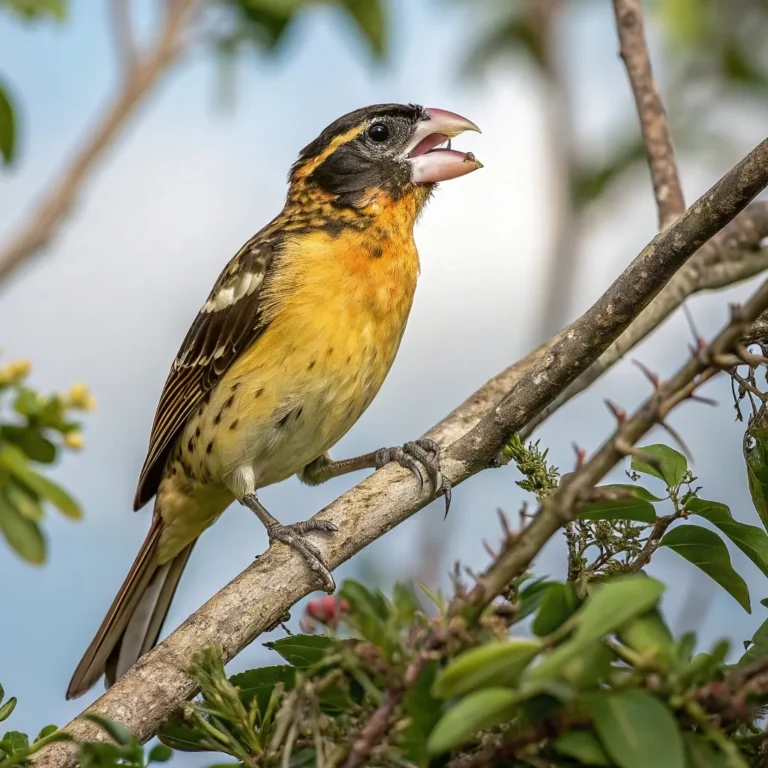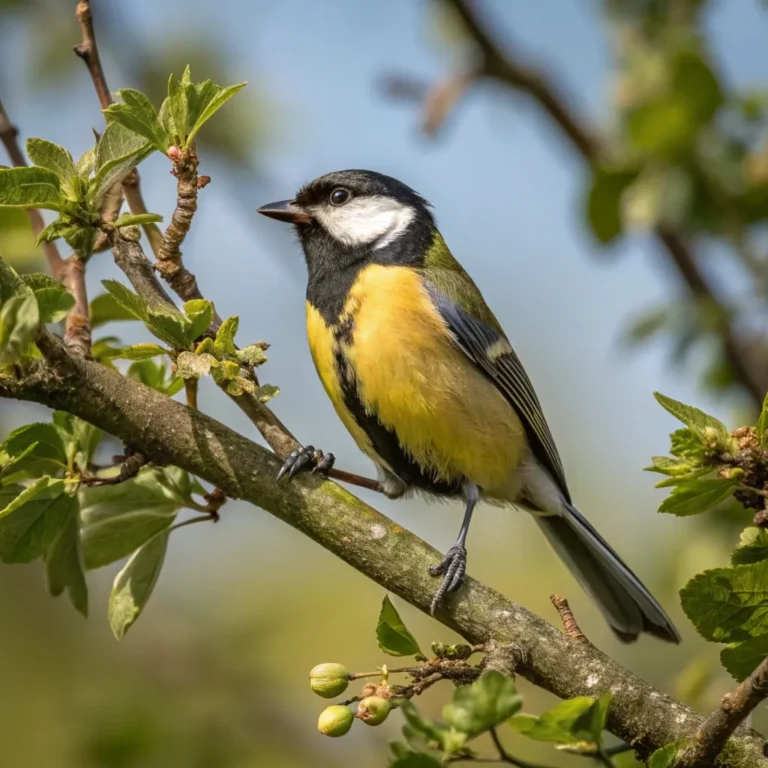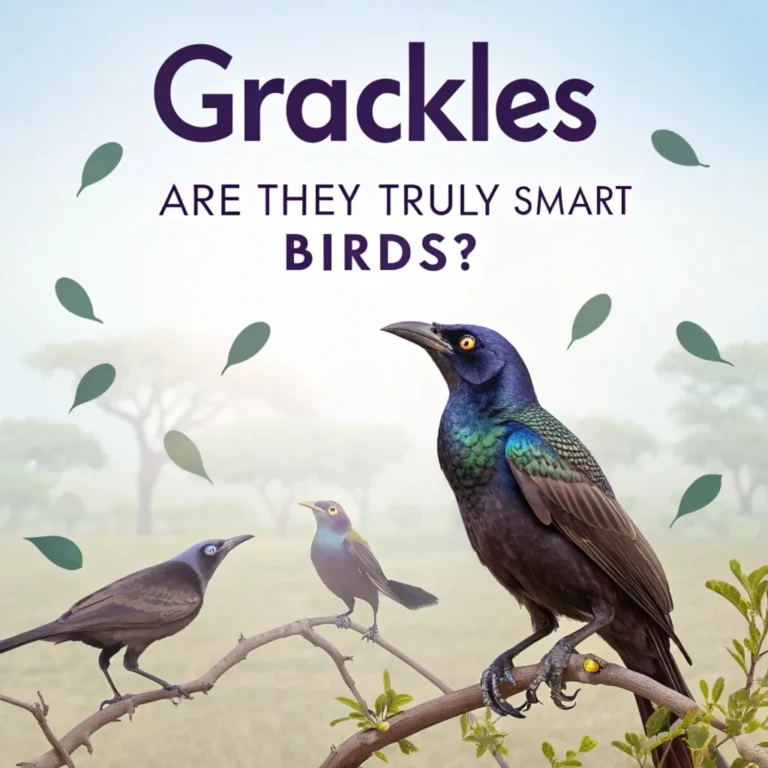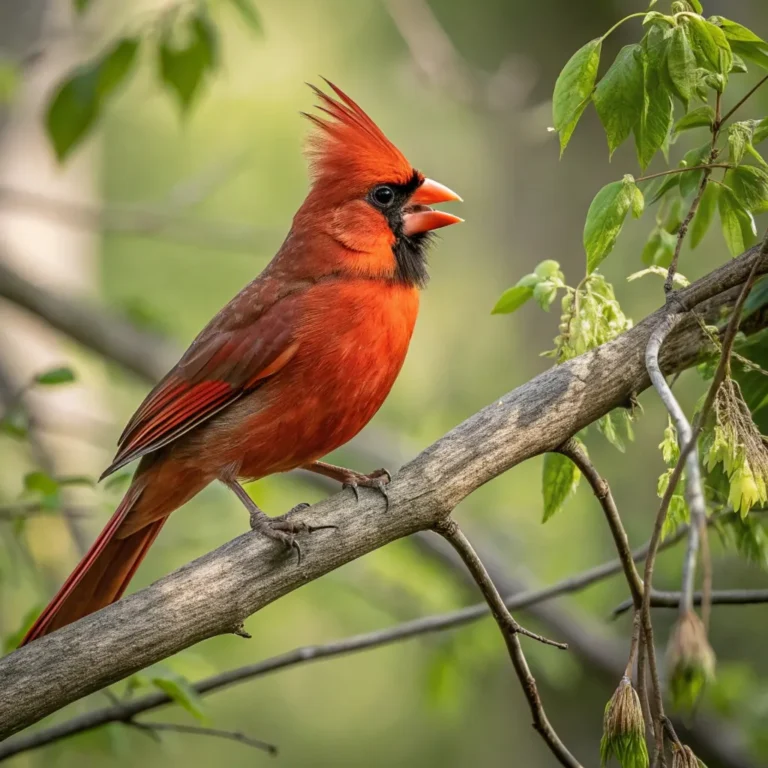Tufted Titmouse: A Guide to its Distinctive Features and Behaviors
The tufted titmouse, a small yet captivating bird, draws attention with its distinctive crest and lively behavior.
This guide explores the life of this adaptable songbird, from its physical traits to its ecological role.
We delve into the tufted titmouse’s habits, habitat preferences, and unique behaviors, offering insights for bird enthusiasts and nature lovers.
Discover how this resilient species thrives in various environments, from forests to urban areas, and learn about its importance in local ecosystems.
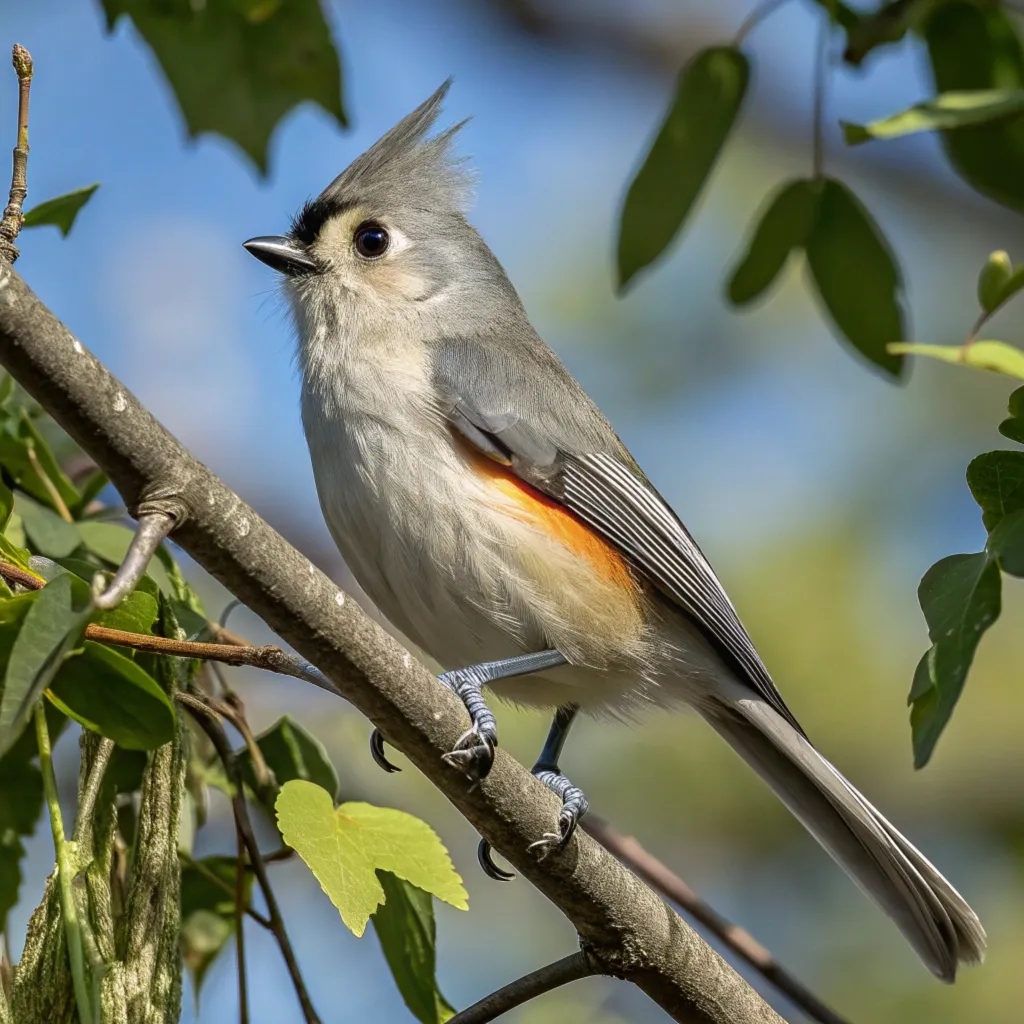
Key Takeaways: Tufted Titmouse at a Glance
- The tufted titmouse (Baeolophus bicolor) is a small, gray-plumed songbird with a prominent crest.
- These birds inhabit deciduous and mixed forests, as well as urban and suburban areas.
- Tufted titmice are omnivorous, consuming a variety of insects, seeds, nuts, and berries.
- They are monogamous, forming long-term pair bonds and often nesting in tree cavities.
- The species has been expanding its range northward since the 1940s, possibly due to climate change.
- Tufted titmice play a crucial role in forest ecosystems and are popular visitors to backyard bird feeders.
- These birds possess unique behaviors, including an alarm call that seems to fade into the distance.
- Tufted titmice often forage in mixed-species flocks during winter, associating with chickadees and nuthatches.
- They demonstrate remarkable adaptability to various habitats, including urban and suburban environments.
- Understanding tufted titmouse behavior and ecology contributes to bird conservation efforts and enhances birdwatching experiences.
The tufted titmouse has captured the hearts of bird enthusiasts and researchers alike with its charming personality and adaptive behaviors.
As we delve deeper into the world of this fascinating songbird, we’ll uncover the intricate details of its life cycle, from its distinctive appearance to its complex social interactions and ecological importance.
These small yet resilient birds serve as a testament to nature’s ability to thrive in changing environments. By studying and appreciating the tufted titmouse, we gain valuable insights into avian ecology and the delicate balance of our ecosystems.
Physical Characteristics: A Distinctive Appearance
The tufted titmouse boasts a unique appearance that sets it apart from other songbirds. Its most striking feature is the prominent crest of gray feathers atop its head, giving it a distinctive silhouette. The bird’s plumage is predominantly gray, creating a sleek and elegant appearance.
One of the most captivating aspects of the tufted titmouse is its large, dark eyes. These liquid black orbs contribute to the bird’s alert and curious expression, often drawing the attention of observers. The contrast between the gray plumage and the dark eyes creates a visually striking effect.
The tufted titmouse’s physical attributes are not just for show; they serve important functions in the bird’s daily life.
The crest, for instance, can be raised or lowered to communicate various emotions and intentions, from curiosity to alarm. This visual signaling plays a crucial role in interactions with both conspecifics and other species.
While the gray plumage may seem plain at first glance, it provides excellent camouflage against tree bark and overcast skies, helping the tufted titmouse avoid predators.
Habitat Preferences: From Forests to Backyards
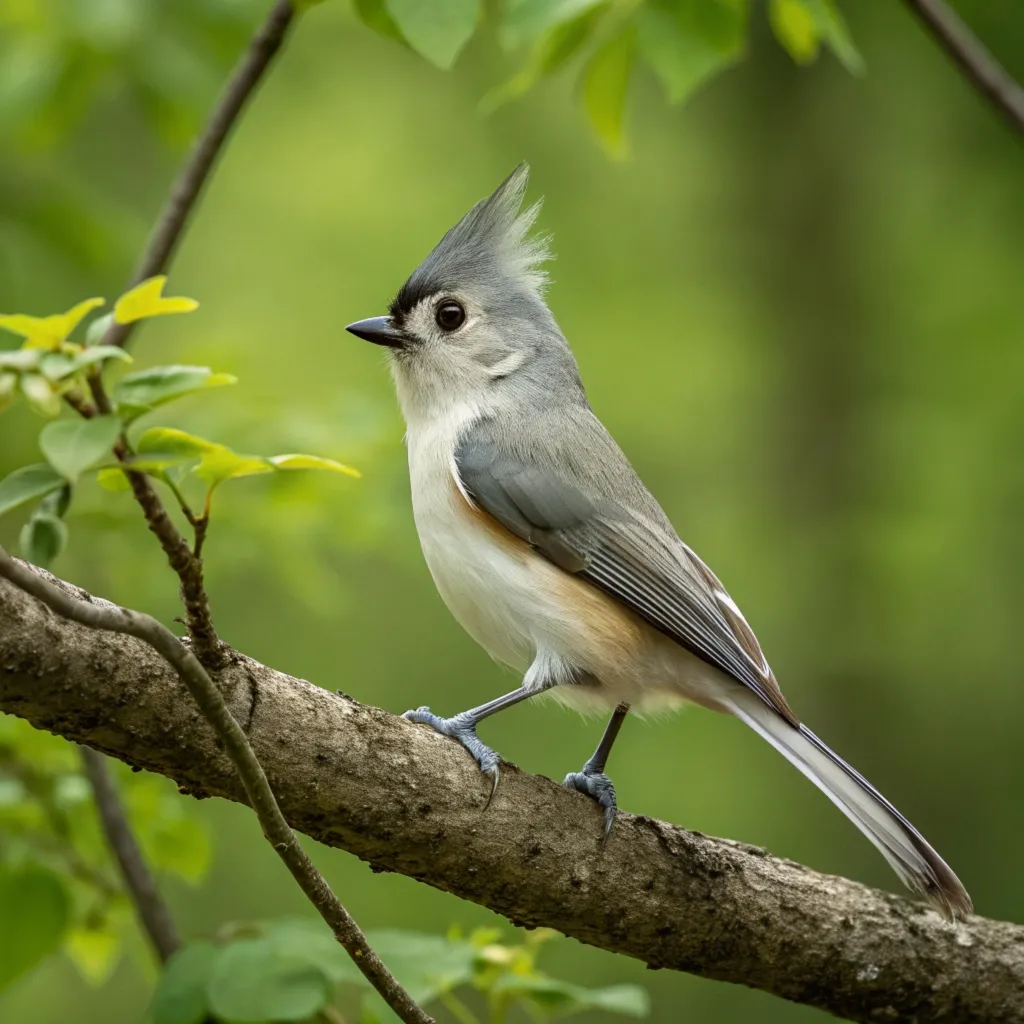
Tufted titmice display remarkable adaptability in their choice of habitats. These birds primarily inhabit deciduous woods or mixed evergreen-deciduous forests, favoring areas with a dense canopy and diverse tree species. However, their range has expanded to include various environments.
In recent decades, tufted titmice have become increasingly common in urban and suburban areas. They readily adapt to human-altered landscapes, frequenting parks, orchards, and residential neighborhoods.
This adaptability has contributed to their range expansion and increased interactions with humans.
The tufted titmouse’s ability to thrive in diverse habitats is a testament to its resilience and adaptability. This flexibility has allowed the species to expand its range and population, even as many other bird species face declining numbers due to habitat loss and environmental changes.
The presence of tufted titmice in urban and suburban areas provides unique opportunities for human-wildlife interactions, fostering a greater appreciation for local biodiversity.
Dietary Habits: A Varied and Opportunistic Menu
The tufted titmouse is an omnivorous bird with a diverse diet that changes seasonally. During the summer months, their diet consists primarily of insects, including:
- Caterpillars
- Beetles
- Ants
- Wasps
- Stink bugs
- Treehoppers
In addition to insects, tufted titmice also consume spiders and snails, providing a rich source of protein. As the seasons change, their diet shifts to include more plant-based foods.
They eagerly consume a variety of seeds, nuts, and berries, with a particular fondness for:
- Acorns
- Beech nuts
- Sunflower seeds
- Various berries
The diverse diet of the tufted titmouse plays a crucial role in its survival and adaptability. By consuming a wide range of food items, these birds can adjust their foraging habits to match seasonal availability and local conditions. This flexibility allows them to thrive in various habitats and weather conditions.
Their dietary choices also have broader ecological implications, as tufted titmice contribute to insect control and seed dispersal in their environments.
Foraging Behavior: Clever and Adaptable

Tufted titmice exhibit fascinating foraging behaviors that showcase their intelligence and adaptability.
These birds are known to scout feeders from cover, quickly darting in to grab a seed before retreating to a safe location to consume their prize. This cautious approach helps them avoid potential predators.
One of the most interesting aspects of tufted titmouse foraging behavior is their ability to use their feet to hold seeds while breaking them open.
This skill, shared by only a few other perching birds, allows them to efficiently process larger seeds and nuts.
The foraging techniques employed by tufted titmice demonstrate their problem-solving abilities and resourcefulness. These birds have been observed using creative methods to access food sources, such as hanging upside down to reach seeds or using their beaks to pry open tough shells.
Their adaptable foraging strategies contribute to their success in various environments, from dense forests to urban gardens.
Social Behavior: Flocking and Family Dynamics
While tufted titmice are not as gregarious as some other bird species, they do exhibit interesting social behaviors. During the winter months, they often join mixed-species foraging flocks, associating with:
- Chickadees
- Nuthatches
- Woodpeckers
- Brown Creepers
These mixed flocks provide several benefits, including increased foraging efficiency and improved predator detection.
Tufted titmice are generally monogamous, forming long-term pair bonds. Unlike many other bird species, tufted titmouse pairs often remain on their territory year-round, rather than joining larger flocks outside the breeding season.
The social structure of tufted titmice is complex and dynamic, adapting to seasonal changes and environmental conditions.
During the breeding season, pairs become more territorial, defending their nesting sites and foraging areas from intruders. This behavior ensures the best possible resources for raising their young.
In winter, the formation of mixed-species flocks showcases the tufted titmouse’s ability to cooperate with other bird species for mutual benefit.
Breeding and Nesting Habits: Family-Oriented Birds
The breeding season for tufted titmice typically occurs from late March to mid-June. These birds are cavity nesters but lack the ability to excavate their own nesting sites. Instead, they rely on:
- Natural tree cavities
- Abandoned woodpecker holes
- Artificial nest boxes
Tufted titmice line their nests with soft materials such as hair, fur, or wool. Interestingly, they may incorporate pieces of shed snake skin into their nests when available, possibly as a deterrent to predators.
The female typically lays a clutch of 5 to 7 eggs, which are white or cream-colored with brownish or purplish spots. She incubates the eggs for about 12-14 days, while the male brings her food. Once hatched, the chicks are altricial, meaning they are born blind and helpless.
The breeding process of tufted titmice is a testament to their parental dedication and adaptability. Both parents work tirelessly to care for their young, with the male taking on the role of provider during incubation and assisting in feeding the chicks once they hatch.
This cooperative parenting strategy increases the chances of survival for their offspring, contributing to the species’ overall success.
Unique Behaviors: Clever Adaptations
Tufted titmice have developed several intriguing behaviors that contribute to their survival and success:
- Alarm Call Deception: Tufted titmice possess an alarm call that seems to fade into the distance, creating the illusion that the bird is moving away. This clever adaptation can mislead predators and birdwatchers alike, allowing the titmouse to remain safely hidden.
- Snow Consumption: When water is scarce, tufted titmice will eat snow to meet their hydration needs. This behavior allows them to survive in areas where liquid water may be temporarily unavailable.
- Window Peering: Tufted titmice sometimes perch on window ledges and appear to look into buildings. This behavior may be related to foraging, as they search for insects in wasp and hornet nests that may be attached to structures.
The unique behaviors exhibited by tufted titmice showcase their intelligence and adaptability. These clever adaptations have evolved over time to help the species survive in various environments and situations.
From deceptive alarm calls to innovative foraging techniques, tufted titmice demonstrate a remarkable ability to problem-solve and adapt.
These behaviors not only contribute to the species’ survival but also make them fascinating subjects for birdwatchers and researchers alike.
Conservation Status and Population Trends
Currently, the tufted titmouse is not considered a species of conservation concern. In fact, their population has been expanding northward since the 1940s, with their range now extending almost to the Canadian border in many areas.
Several factors may contribute to this range expansion:
- Climate Change: Warming winter temperatures may allow tufted titmice to survive in areas that were previously too cold.
- Habitat Changes: The increase in mature woodland habitat has provided more suitable environments for these birds.
- Adaptability: Tufted titmice have shown remarkable ability to adapt to urban and suburban environments, including the use of bird feeders.
The population trends of tufted titmice offer a glimmer of hope in the face of widespread declines in many bird species.
Their ability to adapt to changing environments and expand their range demonstrates the potential for some species to thrive despite human-induced habitat alterations and climate change.
However, continued monitoring and conservation efforts are crucial to ensure their long-term success and to understand the factors contributing to their population growth.
Ecological Importance: A Key Forest Species
Tufted titmice play several important roles in their ecosystems:
- Seed Dispersal: By caching seeds and nuts, tufted titmice contribute to forest regeneration and plant dispersal.
- Insect Control: Their consumption of various insects helps to control pest populations in forests and gardens.
- Indicator Species: The presence and abundance of tufted titmice can indicate the health of deciduous forest ecosystems.
The ecological significance of tufted titmice extends far beyond their charming appearance and behavior. As key players in forest ecosystems, these birds contribute to the overall health and biodiversity of their habitats.
Their role in seed dispersal helps maintain forest diversity, while their insect-eating habits provide natural pest control.
By studying tufted titmouse populations and behaviors, scientists can gain valuable insights into the health of forest ecosystems and the impacts of environmental changes.
Attracting Tufted Titmice: Backyard Birdwatching Tips
For bird enthusiasts looking to attract tufted titmice to their yards, consider the following tips:
- Provide Appropriate Food: Offer sunflower seeds, peanuts, and suet at bird feeders.
- Install Nest Boxes: Place nest boxes in quiet areas of your yard to encourage breeding.
- Maintain Natural Habitat: Preserve mature trees and create a diverse landscape with native plants.
- Offer Water Sources: Provide bird baths or small water features for drinking and bathing.
Creating a tufted titmouse-friendly environment in your backyard not only attracts these charming birds but also supports local biodiversity.
By providing food, water, and nesting sites, you can create a haven for tufted titmice and other bird species, contributing to their conservation and enhancing your birdwatching experiences.
Remember that consistency is key when attracting birds, as they will come to rely on the resources you provide.
Tufted Titmouse Vocalizations: A Diverse Repertoire
Tufted titmice are known for their varied and frequent vocalizations. Their most common call is a clear, whistled “peter-peter-peter” or “here-here-here.” These calls serve various purposes, including:
- Territorial defense
- Mate attraction
- Communication within family groups
- Alarm signals
Understanding these vocalizations can enhance birdwatching experiences and provide insights into tufted titmouse behavior.
The vocal repertoire of tufted titmice is not only diverse but also highly context-specific. Different calls and songs are used in various situations, from defending territory to coordinating movements within a flock.
By learning to recognize these vocalizations, birdwatchers can gain a deeper understanding of tufted titmouse behavior and social dynamics.
These vocal communications play a crucial role in the species’ survival and social interactions, highlighting the complexity of avian communication systems.
Tufted Titmouse Intelligence: Problem-Solving Skills
Recent studies have highlighted the impressive cognitive abilities of tufted titmice. These birds demonstrate problem-solving skills and tool use, such as:
- Using small objects to pry open seeds or nuts
- Learning to open novel food containers
- Adapting quickly to new food sources in their environment
These behaviors showcase the adaptability and intelligence that have contributed to the success of tufted titmice in various habitats.
The cognitive abilities of tufted titmice extend beyond simple instinctual behaviors, demonstrating a level of intelligence that allows them to adapt to new challenges and opportunities.
Their problem-solving skills and ability to learn from experience contribute to their success in diverse environments, from forests to urban areas.
These cognitive traits highlight the complexity of avian intelligence and the importance of behavioral flexibility in species survival and adaptation.
Seasonal Changes: Adapting to the Annual Cycle
Tufted titmice exhibit behavioral and physiological changes throughout the year to adapt to seasonal variations:
- Spring: Increased vocalization and territorial behavior as breeding season begins
- Summer: Focus on raising young and consuming protein-rich insects
- Fall: Increased foraging and caching of seeds and nuts for winter
- Winter: Formation of mixed-species flocks and reliance on cached food
Understanding these seasonal patterns provides valuable insights into the life cycle of tufted titmice and their ecological interactions.
The seasonal adaptations of tufted titmice showcase their remarkable ability to adjust to changing environmental conditions. These adaptations involve not only behavioral changes but also physiological adjustments, such as increased fat storage in preparation for winter.
By aligning their activities and energy expenditure with seasonal resource availability, tufted titmice maximize their chances of survival and reproductive success throughout the year.
Human Interactions: Backyard Visitors and Citizen Science
The adaptability of tufted titmice to urban and suburban environments has increased their interactions with humans. These interactions provide opportunities for:
- Birdwatching and nature appreciation
- Citizen science projects tracking population trends and behavior
- Environmental education and conservation awareness
By engaging with tufted titmice, people can develop a greater appreciation for local biodiversity and the importance of habitat conservation.
The increased presence of tufted titmice in human-populated areas has created unique opportunities for public engagement with wildlife.
As these charming birds become regular visitors to backyard feeders, they serve as ambassadors for avian conservation, inspiring people to take an interest in local ecosystems and wildlife protection.
Citizen science projects involving tufted titmice not only contribute valuable data to scientific research but also foster a sense of stewardship for the natural world among participants.
FAQs About Tufted Titmice
How long do tufted titmice live?
Tufted titmice typically live for 2-3 years in the wild, although some individuals have been recorded living up to 13 years.
Do tufted titmice migrate?
Tufted titmice are generally non-mi

Joyce is the passionate founder of Chirping Hearts, a website dedicated to sharing her love for birds and providing valuable information about avian life. With a background in ornithology and years of experience in birdwatching, Joyce aims to inspire others to appreciate the beauty and diversity of birds. Through her engaging articles and guides, she hopes to foster a community of bird enthusiasts who share her enthusiasm for these incredible creatures. When she’s not writing, Joyce enjoys exploring nature trails and observing birds in their natural habitats.

